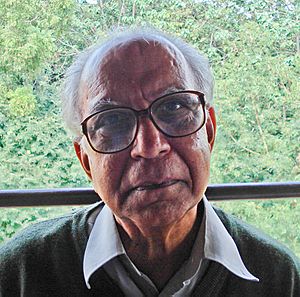M. S. Narasimhan facts for kids
Quick facts for kids
M. S. Narasimhan
|
|
|---|---|

Narasimhan in 2010
|
|
| Born |
Mudumbai Seshachalu Narasimhan
7 June 1932 Tandarai, Madras Presidency, British India
|
| Died | 15 May 2021 (aged 88) |
| Alma mater | Tata Institute of Fundamental Research |
| Spouse(s) | Sakuntala Narasimhan |
| Children | 2 (including Shobhana) |
| Scientific career | |
| Fields | Mathematics |
| Institutions | Tata Institute of Fundamental Research, International Center for Theoretical Physics |
| Doctoral advisor | K. S. Chandrasekharan |
| Doctoral students |
|
Mudumbai Seshachalu Narasimhan (7 June 1932 – 15 May 2021) was a very important Indian mathematician. He was known for his work in many areas of math, like number theory (which studies numbers) and algebraic geometry (which uses algebra to solve geometry problems).
He was a pioneer in studying something called "moduli spaces" of "holomorphic vector bundles." This sounds complicated, but it means he helped create new ways to understand shapes and spaces using advanced math. His work is key to the Kobayashi–Hitchin correspondence, which connects different types of geometry. He also worked with another mathematician, C. S. Seshadri, to prove the Narasimhan–Seshadri theorem. This theorem is very important for understanding "stable vector bundles" on Riemann surfaces.
For his amazing contributions, Narasimhan received many awards. He was given the Padma Bhushan in 1990, which is one of India's highest civilian honors. He also received the Ordre national du Mérite from France in 1989. He was a chosen member of the Royal Society in London, a very old and respected scientific group. He also won the Shanti Swarup Bhatnagar Prize in 1975. He was the only Indian person to receive the King Faisal International Prize in science.
Contents
Early Life and Education
Narasimhan was born on June 7, 1932. He grew up in a small village called Tandarai in what is now Tamil Nadu, India. He was the oldest of five children.
After finishing his early schooling in the countryside, he went to Loyola College in Madras. There, he studied under a French professor named Father Charles Racine. Father Racine had studied with a famous French mathematician, Élie Cartan.
In 1953, Narasimhan joined the Tata Institute of Fundamental Research (TIFR) in Mumbai. He earned his Ph.D. from the University of Mumbai in 1960. His main teacher there was K. S. Chandrasekharan, who was known for his work in number theory.
Career Highlights
Narasimhan started working at the Tata Institute of Fundamental Research (TIFR) in 1960. He later became an honorary member there. At TIFR, he focused on studying different types of mathematical operators, like partial differential operators.
During this time, he visited France. He was invited by a mathematician named Laurent Schwartz. In France, he learned from other famous French mathematicians like Jean-Pierre Serre and Jean Leray.
While in France, he worked with a Japanese mathematician named Takeshi Kotake. They worked on theorems for specific types of "elliptic operators." Their work together is known as the Kotake–Narasimhan theorem.
Important Collaborations
Narasimhan worked closely with Indian mathematician C. S. Seshadri. Their joint work led to the famous Narasimhan–Seshadri theorem. This theorem has been very important in algebraic geometry and number theory for over 50 years. It connected two big areas of modern geometry: differential geometry and algebraic geometry. Both Narasimhan and Seshadri became Fellows of the Royal Society because of this important work.
He also worked with mathematician R. R. Simha. They proved that certain complex structures exist on a real analytic manifold. These were called Simha – Narasimhan measures.
Narasimhan was seen as a leader in studying "moduli spaces" of "holomorphic vector bundles." His research laid the groundwork for the Kobayashi–Hitchin correspondence. This correspondence links differential geometry and algebraic geometry for "vector bundles" over "complex manifolds."
Later Career and Recognition
When the National Board of Higher Mathematics was created in India, Narasimhan was its first chairman. In 1992, he retired from TIFR. After that, he became the head of the mathematics research group at the International Centre for Theoretical Physics in Trieste, Italy. He also visited the Institute for Advanced Study in Princeton, New Jersey, in 1968. After retiring from ICTP, he moved back to Bangalore, India.
He was a Fellow of the Royal Society in London. He also received the French National Order of Merit in 1989. In 1990, he was awarded the Padma Bhushan, one of India's highest honors. He also won the Shanti Swarup Bhatnagar Prize in 1975 and the Srinivasa Ramanujan Medal in 1988.
In 2006, he received the King Faisal International Prize for Science. He shared this award with mathematician Simon Donaldson. As of 2021, Narasimhan was the only Indian person to have won this prestigious science prize.
Personal Life
Narasimhan was married to Sakuntala Narasimhan. She was a classical musician, a journalist, and an activist for consumer rights. They had two children. Their daughter, Shobhana Narasimhan, is also a scientist and a professor.
Narasimhan enjoyed Indian classical music, modern art, painting, and Tamil literature.
He passed away on May 15, 2021, in Bangalore. He was 88 years old and had been receiving treatment for cancer.
See also
 In Spanish: M. S. Narasimhan para niños
In Spanish: M. S. Narasimhan para niños

